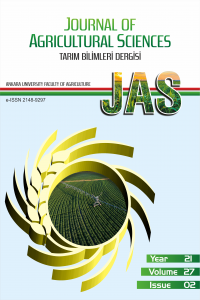Effects of Kefir Powder Fortification on Yogurt Qual
Effects of Kefir Powder Fortification on Yogurt Qual
___
- Ahmed Z, Yanping W, Asıf A, Salman T K, Mehrun N, Hajra A & Asma A (2013). Kefir and health, a contemporary perspective. Critical Reviews in Food Science and Nutrition 53: 422-434
- AOAC International (1992). Official Methods of Analysis. 14th ed. AOAC International, Arlington, VA
- Ashraf R & Shah N P (2011). Selective and differential enumerations of Lactobacillus delbrueckii subsp. bulgaricus, Streptococcus thermophilus, Lactobacillus acidophilus, Lactobacillus casei and Bifidobacterium spp. in yoghurt. International Journal of Food Microbiology 149: 194-208
- Atamer M & Sezgin E (1986). Yoğurtlarda kurumadde artırımının pıhtının fiziksel özellikleri üzerine etkisi. Gıda 11: 327-331
- Cais-Sokolinska D & Pikul J (2006). Use of colour measurement to evaluate yoghurt quality during storage. Itallian Journal of Food Science 18: 63-71
- Dave R I & Shah N P (1997). Viability of yoghurt and probiotic bacteria in yoghurts made from commercial starter cultures. International Dairy Journal 7: 31-41
- Guzel-Seydim Z B, Sezgin E & Seydim A C (2005). Influences of exopolysaccharide producing cultures on the quality of plain set type yogurt. Food Control 16: 205-209
- Guzel-Seydim Z B, Kok-Taş T, Greene A K & Seydim A C (2011). Review: Functional properties of kefir. Food Science and Nutrition 51: 261-268
- Kök Taş T, Ekinci F Y & Guzel-Seydim Z B (2012). Identification of microbial flora in kefir grains produced in Turkey using PCR. International Journal of Dairy Technology 65: 126-131
- Lourens-Hattingh A & Viljoen B C (2001). Yogurt as probiotic carrier food. International Dairy Journal 11: 1-17
- Meilgaard M, Civille G V & Carr B T (1999). Sensory Evaluation Techniques. 3rd Ed. USA: CRC Press, LLC
- Mossel D A A, Corry J E L, Stuijk C B & Baird R M (1995). Essential of the microbiology of food: a texbook for advance studies (1th ed.). John Wiley, New York
- Özer B H, Uzun Y S & Kırmacı H A (2008). Effect of cell immobilization on viability of Lactobacillus acidophilus LA-5 and Bifidobacterium bifidum BB12 in kasar cheese. International Journal of Dairy Technology 61: 237-244
- Ranadheera C S, Evans C A, Adams M C & Baines S K (2012). Probiotic viability and physico-chemical and sensory properties of plain and stirred fruit yogurts made from goat`s milk. Food Chemistry 135: 1411-1418
- Routray W & Mishra H N (2011). Scientific and technical aspects of yogurt aroma and taste. Comprehensive Reviews in Food Science and Food Safety 10: 208-220 Y
- alçın S (1985). Yogurtta aroma ve lezzet bileşiklerinin oluşumu. A.U. Veteriner Fakültesi Dergisi 32: 237-249.
- Yılmazer M & Seçilmiş H (2006). Gaz kromatografisi headspace sistemi ile süt ürünlerinde bazı aroma bileşenlerinin analizi. Türkiye 9. Gıda Kongresi, 24-26 Mayıs, Abant İzzet Baysal Üniversitesi, Bolu, s. 625-628
- ISSN: 1300-7580
- Yayın Aralığı: Yılda 4 Sayı
- Başlangıç: 1995
- Yayıncı: Ankara Üniversitesi
Fatma COŞKUN, Muhammet ARICI, Mehmet GULCU, Gülnaz ÇELİKYURT, Mustafa MIRIK
Effects of Kefir Powder Fortification on Yogurt Qual
Burcu BOZOVA, Tuğba KÖK TAŞ, Zeynep GÜZEL SEYDİM
A Visual Assessment of Roadside Poplar Plantings in Turkey
Effects of Ozone Treatment on the Degradation and Toxicity of Several Pesticides in Different Grou
Yakup Sedat VELIOGLU, Şeyda FİKİRDEŞİCİ ERGEN, Pelin AKSU, Ahmet ALTINDAĞ
Abdullah GÜLLER, Hikmet Murat SİPAHİOĞLU, Mustafa USTA, Emre Demirer DURAK
Gülfem ÜNAL, Cem KARAGÖZLÜ, Özer KINIK, Ecem AKAN, Ayşe Sibel AKALIN
Proteolysis in the Beyaz (White) Cheese Produced From Various Milk
Multilevel Analysis for Repeated Measures Data in Lambs1
